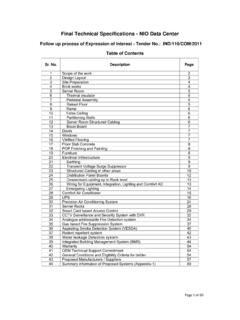Transcription of Java® For Dummies®, 7th Edition
1 Java For Dummies , 7th EditionPublished by: John Wiley & Sons, Inc., 111 River Street, Hoboken, NJ07030-5774, 2017 by John Wiley & Sons, Inc., Hoboken, New JerseyPublished simultaneously in CanadaNo part of this publication may be reproduced, stored in a retrieval system ortransmitted in any form or by any means, electronic, mechanical,photocopying, recording, scanning or otherwise, except as permitted underSections 107 or 108 of the 1976 United States Copyright Act, without theprior written permission of the Publisher. Requests to the Publisher forpermission should be addressed to the Permissions Department, John Wiley& Sons, Inc.
2 , 111 River Street, Hoboken, NJ 07030, (201) 748-6011, fax(201) 748-6008, or online at : Wiley, For Dummies, the Dummies Man logo, ,Making Everything Easier, and related trade dress are trademarks orregistered trademarks of John Wiley & Sons, Inc. and may not be usedwithout written permission. Java is a registered trademark of Oracle America,Inc. Android is a registered trademark of Google, Inc. All other trademarksare the property of their respective owners. John Wiley & Sons, Inc. is notassociated with any product or vendor mentioned in this OF LIABILITY/DISCLAIMER OF WARRANTY: THEPUBLISHER AND THE AUTHOR MAKE NO REPRESENTATIONS ORWARRANTIES WITH RESPECT TO THE ACCURACY ORCOMPLETENESS OF THE CONTENTS OF THIS WORK ANDSPECIFICALLY DISCLAIM ALL WARRANTIES, INCLUDINGWITHOUT LIMITATION WARRANTIES OF FITNESS FOR APARTICULAR PURPOSE.
3 NO WARRANTY MAY BE CREATED OREXTENDED BY SALES OR PROMOTIONAL MATERIALS. THEADVICE AND STRATEGIES CONTAINED HEREIN MAY NOT BESUITABLE FOR EVERY SITUATION. THIS WORK IS SOLD WITHTHE UNDERSTANDING THAT THE PUBLISHER IS NOT ENGAGEDIN RENDERING LEGAL, ACCOUNTING, OR OTHER PROFESSIONALSERVICES. IF PROFESSIONAL ASSISTANCE IS REQUIRED, THESERVICES OF A COMPETENT PROFESSIONAL PERSON SHOULD BESOUGHT. NEITHER THE PUBLISHER NOR THE AUTHOR SHALL BELIABLE FOR DAMAGES ARISING HEREFROM. THE FACT THAT ANORGANIZATION OR WEBSITE IS REFERRED TO IN THIS WORK ASA CITATION AND/OR A POTENTIAL SOURCE OF FURTHERINFORMATION DOES NOT MEAN THAT THE AUTHOR OR THEPUBLISHER ENDORSES THE INFORMATION THE ORGANIZATIONOR WEBSITE MAY PROVIDE OR RECOMMENDATIONS IT MAYMAKE.
4 FURTHER, READERS SHOULD BE AWARE THAT INTERNETWEBSITES LISTED IN THIS WORK MAY HAVE CHANGED ORDISAPPEARED BETWEEN WHEN THIS WORK WAS WRITTEN ANDWHEN IT IS general information on our other products and services, please contactour Customer Care Department within the at 877-762-2974, outside at 317-572-3993, or fax 317-572-4002. For technical support, pleasevisit publishes in a variety of print and electronic formats and by print-on-demand. Some material included with standard print versions of this bookmay not be included in e-books or in print-on-demand. If this book refers tomedia such as a CD or DVD that is not included in the version youpurchased, you may download this material For more information about Wileyproducts, visit of Congress Control Number: 2017932837 ISBN: 978-1-119-23555-2; 978-1-119-23558-3 (ebk).
5 978-1-119-23557-6(ebk)Java For Dummies To view this book's Cheat Sheet, simply go and search for Java ForDummies Cheat Sheet in the Search of ContentsCoverIntroductionHow to Use This BookConventions Used in This BookWhat You Don t Have to ReadFoolish AssumptionsHow This Book Is OrganizedIcons Used in This BookBeyond the BookWhere to Go from HerePart 1: Getting Started with JavaChapter 1: All about JavaWhat You Can Do with JavaWhy You Should Use JavaGetting Perspective: Where Java Fits InObject-Oriented Programming (OOP)What s Next?Chapter 2: All about SoftwareQuick-Start InstructionsWhat You Install on Your ComputerChapter 3: Using the Basic Building BlocksSpeaking the Java LanguageChecking Out Java Code for the First TimeUnderstanding a Simple Java ProgramAnd Now, a Few CommentsPart 2: Writing Your Own Java ProgramsChapter 4: Making the Most of Variables and TheirValuesVarying a VariableExperimenting with JShellWhat Happened to All the Cool Visual Effects?
6 The Atoms: Java s Primitive TypesThe Molecules and Compounds: Reference TypesAn Import DeclarationCreating New Values by Applying OperatorsChapter 5: Controlling Program Flow with Decision-Making StatementsMaking Decisions (Java if Statements)Using Blocks in JShellForming Conditions with Comparisons and Logical OperatorsBuilding a NestChoosing among Many Alternatives (Java switch Statements)Chapter 6: Controlling Program Flow with LoopsRepeating Instructions Over and Over Again (Java while Statements)Repeating a Certain Number of Times (Java for Statements)Repeating until You Get What You Want (Java do Statements)Part 3: Working with the Big Picture: Object-OrientedProgrammingChapter 7: Thinking in Terms of Classes and ObjectsDefining a Class (What It Means to Be an Account)Defining a Method within a Class (Displaying an Account)Sending Values to and from Methods (Calculating Interest)Making Numbers Look GoodHiding Details with Accessor MethodsBarry s Own GUI ClassChapter 8.
7 Saving Time and Money: Reusing ExistingCodeDefining a Class (What It Means to Be an Employee)Working with Disk Files (a Brief Detour)Defining Subclasses (What It Means to Be a Full-Time or Part-TimeEmployee)Using SubclassesOverriding Existing Methods (Changing the Payments for SomeEmployees)Chapter 9: Constructing New ObjectsDefining Constructors (What It Means to Be a Temperature)More Subclasses (Doing Something about the Weather)A Constructor That Does MorePart 4: Smart Java TechniquesChapter 10: Putting Variables and Methods Where TheyBelongDefining a Class (What It Means to Be a Baseball Player)Making Static (Finding the Team Average)Experiments with VariablesPassing ParametersChapter 11: Using Arrays to Juggle ValuesGetting Your Ducks All in a RowArrays of ObjectsCommand Line ArgumentsChapter 12: Using Collections and Streams (WhenArrays Aren t Good Enough)Understanding the Limitations of ArraysCollection Classes to the RescueFunctional ProgrammingChapter 13.
8 Looking Good When Things TakeUnexpected TurnsHandling ExceptionsHandle an Exception or Pass the BuckFinishing the Job with a finally ClauseA try Statement with ResourcesChapter 14: Sharing Names among the Parts of a JavaProgramAccess ModifiersClasses, Access, and Multipart ProgramsSneaking Away from the Original CodeProtected AccessAccess Modifiers for Java ClassesChapter 15: Fancy Reference TypesJava s TypesThe Java InterfaceAbstract ClassesRelax! You re Not Seeing Double!Chapter 16: Responding to Keystrokes and MouseClicksGo On .. Click That ButtonResponding to Things Other Than Button ClicksCreating Inner ClassesChapter 17: Using Java Database ConnectivityCreating a Database and a TablePutting Data in the TableRetrieving DataDestroying DataPart 5: The Part of TensChapter 18.
9 Ten Ways to Avoid MistakesPutting Capital Letters Where They BelongBreaking Out of a switch StatementComparing Values with a Double Equal SignAdding Components to a GUIA dding Listeners to Handle EventsDefining the Required ConstructorsFixing Non-Static ReferencesStaying within Bounds in an ArrayAnticipating Null PointersHelping Java Find Its FilesChapter 19: Ten Websites for JavaThis Book s WebsiteThe Horse s MouthFinding News, Reviews, and Sample CodeGot a Technical Question?About the AuthorConnect with DummiesEnd User License AgreementIntroductionJava is good stuff. I ve been using it for years.
10 I like Java because it s everything follows simple rules. The rules can seem intimidating attimes, but this book is here to help you figure them out. So, if you want to useJava and you want an alternative to the traditional techie, soft-cover book, sitdown, relax, and start reading Java For Dummies, 7th to Use This BookI wish I could say, Open to a random page of this book and start writing Javacode. Just fill in the blanks and don t look back. In a sense, this is true. Youcan t break anything by writing Java code, so you re always free let me be honest. If you don t understand the bigger picture, writing aprogram is difficult.





